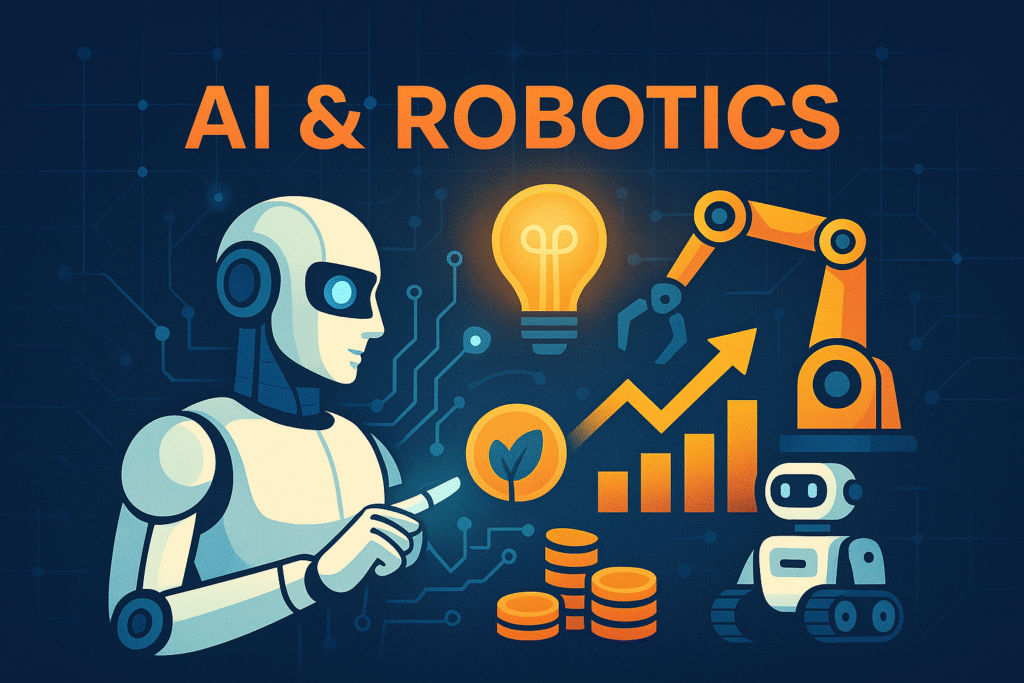Benchmarks that assemble companies at the forefront of artificial-intelligence software, industrial automation, autonomous vehicles and enabling hardware—thereby giving investors a single, transparent gauge of the machines-and-algorithms revolution.

1. Why These Indices Exist
First, AI workloads are reshaping data-center spending, while, at the same time, collaborative robots are re-tooling factory floors. Because these shifts cut across many GICS industries, broad-market indices barely reveal where the value migrates. Consequently, index providers created AI & robotics indices to isolate pure-play leaders and, moreover, to launch thematic ETFs that tap explosive growth without stock-picking.
2. Major Benchmarks at a Glance
| Index | Coverage & Method | Distinctive Feature |
|---|---|---|
| NASDAQ CTA Artificial Intelligence & Robotics (NQROBO) | 100 global stocks, modified cap | Exposure scores from AI patents & revenue tests |
| STOXX Global Automation & Robotics | 120 names, equal-weight, quarterly re-rank | Capped at 2 % to avoid mega-cap dominance |
| Indxx Global Robotics & AI Thematic | 105 stocks, 60 % hardware / 40 % software | Semi-annual rebalance; fast-entry IPO rule |
| Solactive Artificial Intelligence | 80 stocks picked via NLP keyword scan of filings | Reoptimises weights monthly as language trends evolve |
Hence, each benchmark uses unique screens—patents, revenue purity or NLP—to capture the theme.
3. How Pure-Play Selection Works
Although methodologies differ, most follow a two-layer filter:
- Eligibility Universe – Starts with a global, large-mid-cap base such as the STOXX Global 1800.
- Exposure Score – Companies earn 1.0 if ≥ 50 % of revenue or patents derive from AI/robotics; they earn 0.5 if between 20–50 %. Only scores ≥ 0.5 survive.
Weights are then assigned by free-float market cap but, likewise, capped to curb over-concentration in Nvidia-like giants.
4. Snapshot (April 2025 – NASDAQ CTA Robo Index)
| Metric | Figure |
|---|---|
| Constituents | 100 |
| Float-Adj. Market Cap | US $1.9 trillion |
| Regional Split | U.S. 66 %, Japan 11 %, Europe 9 %, Taiwan 6 %, Rest 8 % |
| Sub-Industry Mix | Semiconductors 33 %, Industrial Automation 25 %, Software 22 %, Sensors 10 %, Autonomous Vehicle Tech 10 % |
| Dividend Yield | 0.5 % |
Top weights—Nvidia 6.8 %, ABB 4.7 %, Intuitive Surgical 4.2 %—are capped each rebalance.
5. Performance Pulse (USD Total Return)
| Period | Robo Index | MSCI ACWI | Driver |
|---|---|---|---|
| 2022 | –27 % | –17 % | Rate-sensitive growth multiples compressed |
| 2023 | +45 % | +21 % | Generative-AI GPU demand |
| 2024 | +19 % | +12 % | Factory-automation cap-ex rebound |
| YTD 2025 | +8.4 % | +5.9 % | Surgical-robot procedure growth |
Thus, volatility of ~28 % exceeds the broad market, yet long-run returns have handily outpaced global equities.
6. Investor Use-Cases
- Pure Thematic Beta: ETFs like ROBO, BOTZ and AIQ mirror these indices, letting investors plug directly into the megatrend.
- Satellite Allocation: CIOs allocate 3-5 % in multi-asset portfolios for growth kicker.
- Hedging & Trading: Options on theme ETFs enable tactical positioning around earnings or chip-cycle swings.
- Benchmarking: Active “future-tech” funds now measure alpha relative to these yard-sticks rather than the Nasdaq-100.
7. Strengths & Limitations
| Strengths | Limitations |
|---|---|
| Transparent, rules-based exposure to cutting-edge tech | High valuation multiples raise drawdown risk |
| Global coverage spreads regulatory risk | U.S. mega-caps can still dominate despite caps |
| Quarterly or semi-annual reviews keep purity high | Theme overlap (e.g., cloud AI vs. pure robotics) varies by provider |
| Back-tests show superior long-term CAGR | Dividend yield negligible; relies on capital gains |
8. Trends to Watch
- Edge-AI Chips: Inclusion of ARM-based and RISC-V suppliers may lift semiconductor sleeve above 35 % by 2026.
- Humanoid Robots: IPO pipeline for bipedal-robot start-ups could reshape mid-cap roster at next reconstitution.
- AI Regulation: EU AI Act compliance costs may hit margins; index rules may shift to favour transparent governance scorers.
- Bio-Robotics & Healthcare: Growing procedure volumes for surgical bots like da Vinci may expand health-care weight faster than factory automation.
Key Takeaways
AI & robotics indices package the complex, fast-evolving automation ecosystem into investible baskets with transparent scoring and capping. While performance can be volatile, these benchmarks—and their ETF trackers—offer concentrated exposure to one of the most transformative forces in the global economy.